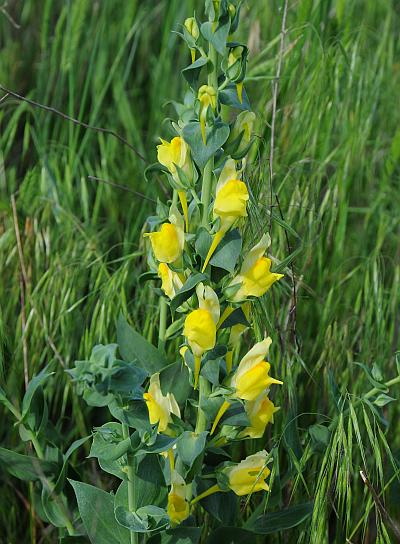Linaria dalmatica (L.) Mill.
Dalmatian Toadflax

Introduced
CC = *
CW =
MOC = 0
© SRTurner
Linaria dalmatica (L.) Mill.Dalmatian Toadflax | |
 |
Introduced CC = * CW = MOC = 0 |
© SRTurner |
|
Family - Plantaginaceae Habit - Rhizomatous perennial forb. Stem - Strongly ascending to erect, to 1 m, usually branched, glabrous, glaucous.
Leaves - Alternate, numerous, simple, sessile, clasping, entire. Blades lanceolate-ovate to ovate, rounded to truncate at the base, pointed at the tip, 2-5 cm long, the venation palmate, glabrous, glaucous.
Inflorescences - Terminal elongated, bracteate racemes.
Flowers - Short-pedicellate or nearly sessile. Sepals 5, free to near base, with roughly equal linear to triangular-ovate lobes, 2-12 mm long. Flowers 5-lobed and 2-lipped, the lower lip rounded on top and larger than the upper lip, corollas 20-50 mm long, bright yellow, with well developed, orange-bearded palate, lower lip closing the throat and side of tube spurred at base, the spur about as long as the rest of the corolla, the lower side of throat swollen and hairy. Stamens 4, in 2 pairs, included.
Fruits - Ovoid-cylindric to globose capsules, 6-8 mm,opening by slits into chambers near tip. Seeds numerous, pyramidal, 1 mm long, irregularly winged.
Flowering - July - August. Habitat - Fields, pastures, open disturbed areas. Origin - Native to Eurasia. Lookalikes - L. vulgaris. Other info. - As of early 2020, this plant has not been found in Missouri. It is included here on a speculative basis, as it seems likely to appear in the state eventually. It is found in every state west of Missouri and in many western states is considered a noxious weed. The plant is easily identified by its characteristic inflorescences and unusual flowers. It is easily distinguished from its sibling L. vulgaris by its broad, clasping leaves. Photographs taken along I-90, Mineral County, MT, 8-23-2012, in Yellowstone NP, Park County, WY, 7-20-2014, in Three Forks, Gallatin County, MT, 6-10-2015, and Laramie County, CO, 7-31-2017 and 6-19-2018 (SRTurner). |